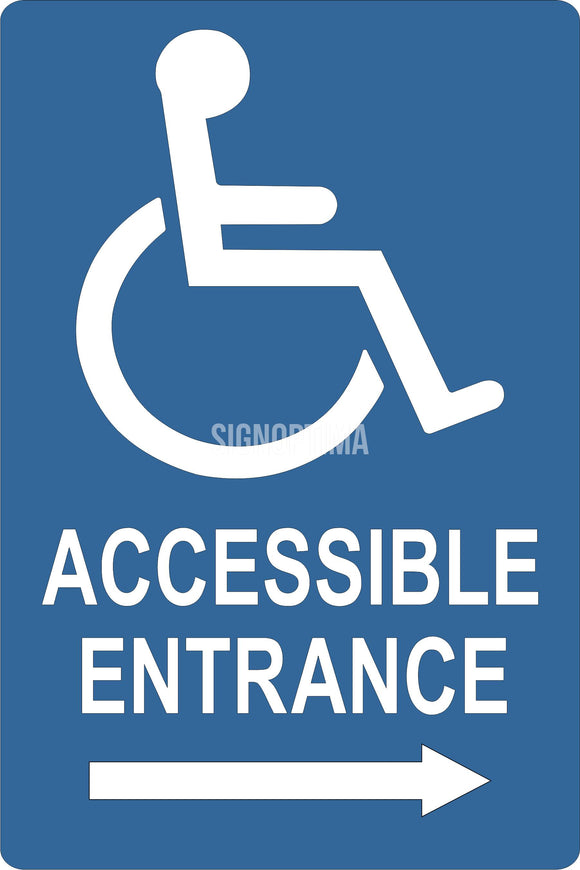Discovering the Secret Functions of ADA Signs for Improved Access
In the realm of ease of access, ADA indications offer as silent yet effective allies, ensuring that areas are inclusive and accessible for individuals with disabilities. By incorporating Braille and responsive elements, these indications break obstacles for the visually damaged, while high-contrast shade schemes and clear fonts cater to varied visual needs.
Relevance of ADA Compliance
Making sure compliance with the Americans with Disabilities Act (ADA) is critical for cultivating inclusivity and equal accessibility in public areas and offices. The ADA, passed in 1990, mandates that all public centers, companies, and transportation services accommodate people with disabilities, ensuring they appreciate the same rights and possibilities as others. Conformity with ADA standards not just fulfills lawful responsibilities yet also enhances an organization's reputation by demonstrating its dedication to variety and inclusivity.
One of the vital elements of ADA compliance is the execution of available signs. ADA signs are developed to ensure that people with specials needs can conveniently browse through areas and buildings.
Furthermore, sticking to ADA policies can mitigate the threat of possible fines and lawful consequences. Organizations that stop working to adhere to ADA standards may face legal actions or fines, which can be both economically troublesome and damaging to their public photo. Thus, ADA conformity is indispensable to promoting an equitable atmosphere for every person.
Braille and Tactile Aspects
The incorporation of Braille and responsive elements right into ADA signage symbolizes the principles of accessibility and inclusivity. These functions are crucial for individuals that are visually impaired or blind, allowing them to navigate public rooms with greater self-reliance and self-confidence. Braille, a tactile writing system, is vital in offering created information in a format that can be quickly regarded with touch. It is typically put under the corresponding text on signs to make sure that people can access the details without visual assistance.
Tactile aspects extend past Braille and consist of elevated signs and characters. These elements are created to be noticeable by touch, enabling individuals to identify room numbers, toilets, leaves, and various other critical areas. The ADA sets particular guidelines regarding the dimension, spacing, and placement of these responsive components to optimize readability and ensure uniformity across different environments.

High-Contrast Shade Systems
High-contrast color pattern play a crucial function in improving the visibility and readability of ADA signage for people with visual problems. These plans are vital as they take full advantage of the difference in light reflectance in between text and history, guaranteeing that indications are conveniently discernible, also from a distance. The Americans with Disabilities Act (ADA) mandates using details shade contrasts to accommodate those with restricted vision, making it an important aspect of conformity.
The efficiency of high-contrast shades exists in their capability to attract attention in different lighting problems, including poorly lit settings and areas with glow. Commonly, dark text on a light background or light text on a dark history is employed to accomplish optimal comparison. For example, black text on a yellow or white history supplies a stark visual distinction that assists in quick recognition and comprehension.

Legible Fonts and Text Dimension
When thinking about the design of ADA signage, the choice of legible typefaces and ideal message dimension can not be overemphasized. The Americans see with Disabilities Act (ADA) mandates that font styles need to be sans-serif and not italic, oblique, script, highly decorative, or of unusual form.
The dimension of the message likewise plays a critical role in accessibility. According to ADA guidelines, the minimal message elevation must be 5/8 inch, and it ought to enhance proportionally with viewing range. This is particularly vital in public rooms where signage requirements to be read promptly and precisely. Consistency in text dimension adds to a cohesive aesthetic experience, helping individuals in navigating settings effectively.
Moreover, spacing between lines and letters is integral to legibility. Ample spacing stops personalities from showing up crowded, enhancing readability. By adhering to these criteria, designers can significantly enhance ease of access, ensuring that signage offers its intended function for all people, no matter of their visual capacities.
Effective Placement Approaches
Strategic placement of ADA signage is essential for making best use of availability and making certain compliance with legal criteria. Appropriately located signs assist people with disabilities efficiently, promoting navigation in public areas. Secret factors to consider consist of distance, height, and visibility. ADA standards specify that indicators should be installed at a height between 48 to 60 inches from the ground to ensure they are within the line of sight for both standing and seated individuals. This conventional elevation array is essential for inclusivity, enabling wheelchair users and individuals of varying heights to access information effortlessly.
Furthermore, indications need to be placed surrounding to the latch side of doors to allow simple identification before entry. Uniformity in sign positioning throughout a facility boosts predictability, lowering complication and boosting overall user experience.

Final Thought
ADA signs play an important duty in promoting availability by incorporating features that attend to the requirements of people with specials needs. Including Braille and tactile aspects makes certain vital information comes to the visually impaired, while high-contrast color pattern and legible sans-serif fonts improve presence throughout various lighting conditions. Efficient placement methods, such as ideal mounting heights and tactical places, additionally assist in navigating. These components jointly cultivate a comprehensive environment, highlighting the importance of ADA compliance in ensuring equal access for all.
In the realm of access, ADA indicators offer as silent yet powerful allies, ensuring that rooms are my blog inclusive and accessible go to this website for people with impairments. The ADA, enacted in 1990, mandates that all public facilities, employers, and transportation solutions fit individuals with handicaps, guaranteeing they take pleasure in the exact same rights and possibilities as others. ADA Signs. ADA indications are developed to ensure that people with disabilities can easily browse through spaces and structures. ADA standards state that signs need to be installed at an elevation between 48 to 60 inches from the ground to ensure they are within the line of sight for both standing and seated people.ADA indications play a vital duty in promoting access by integrating features that address the requirements of individuals with specials needs
Comments on “Understanding the Rules Behind ADA Signs”